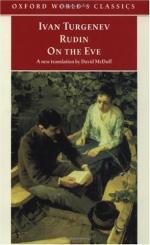|
This section contains 2,934 words (approx. 10 pages at 300 words per page) |

|
SOURCE: Dalton, Margaret. “Common Romantic Motifs: Karolina Pavlova's ‘Dvojnaja žizn’ and Ivan Turgenev's ‘Faust.’” In Alexander Lipson: In Memoriam, pp. 50-8. Columbus, Ohio: Slavica Publishers, 1993.
In the following essay, Dalton finds parallels between Karolina Pavlova's “A Double Life” and Turgenev's “Faust.”
At first glance a comparison between one of the few prose works1 by a prominent nineteenth-century poetess, and a story by a representative of so-called Russian realist fiction hardly seems justified.2 Pavlova's society tale, “A Double Life” (published in 1848), describes the dream experiences of the heroine, Cecilia von Lindenborn, against a background of petty intrigue and manipulation: while Cecilia's mother tries to get her married to the wealthy though empty-headed Prince Viktor, Mme von Lindenborn's best friend, Mme. Valickaja, thwarts this attempt in the interest of her own daughter, and succeeds in seeing Cecilia married to the less wealthy, but morally equally insignificant Ivačinskij. Turgenev's tale...
|
This section contains 2,934 words (approx. 10 pages at 300 words per page) |

|


